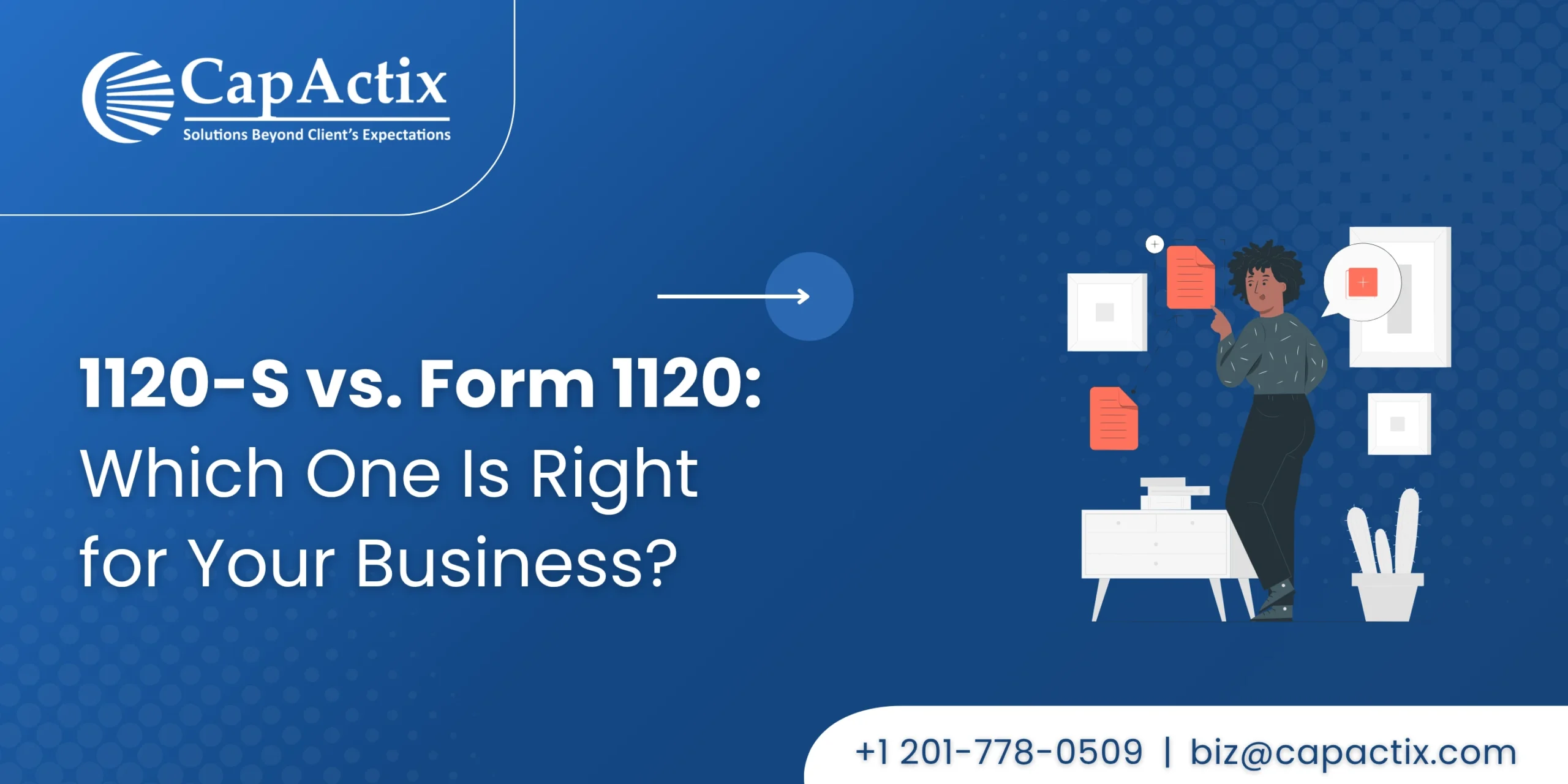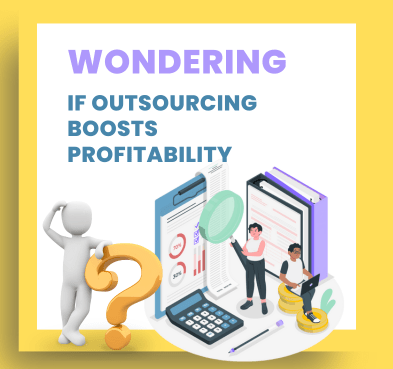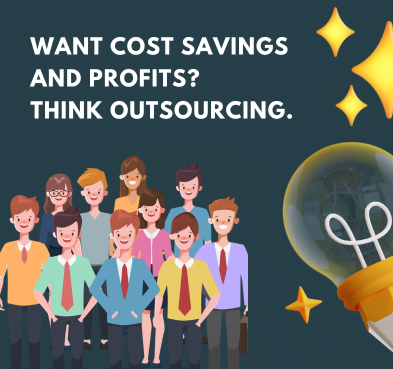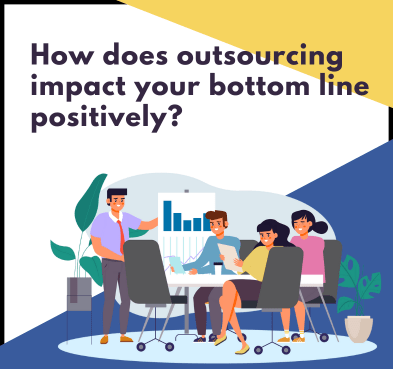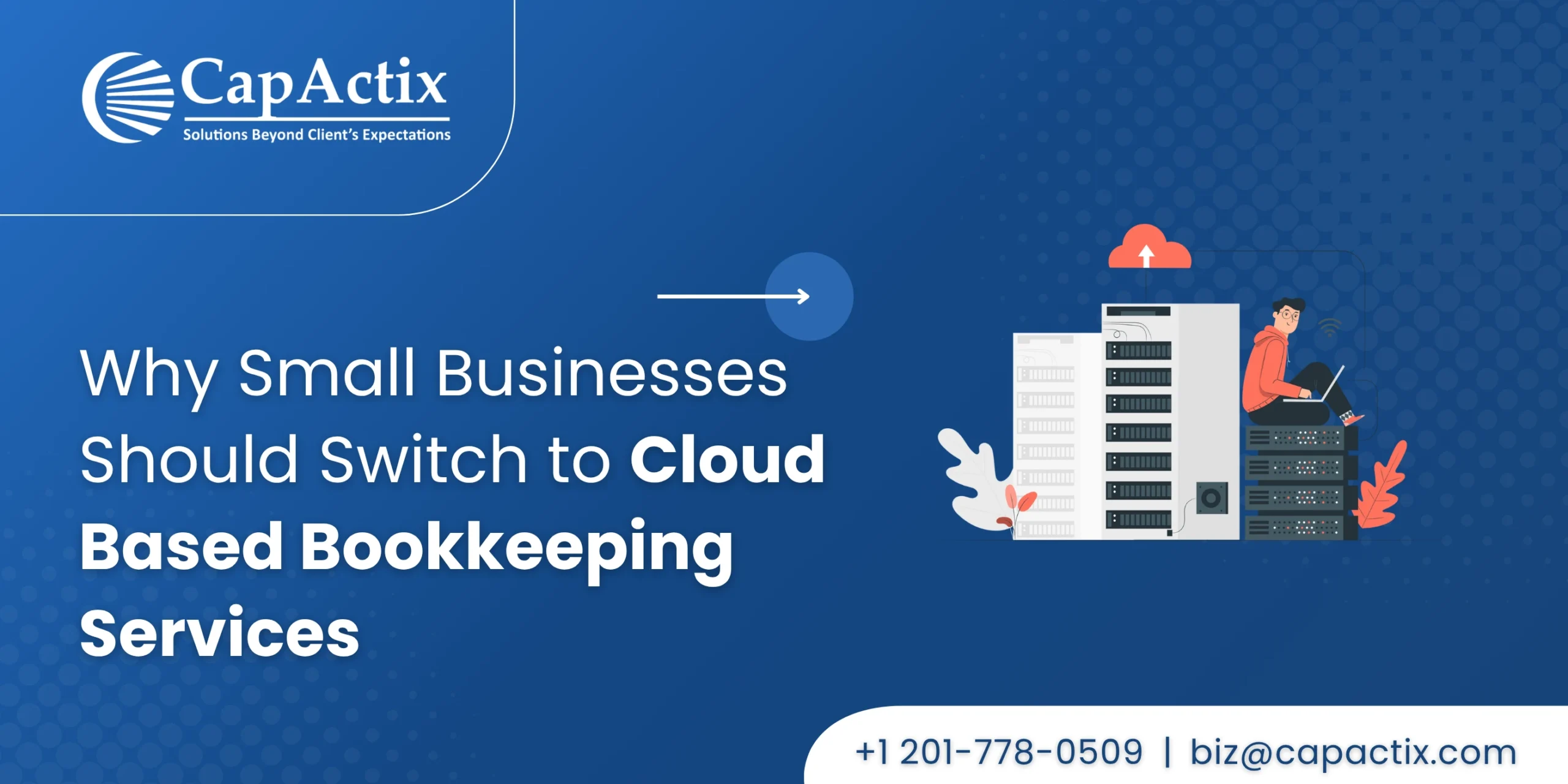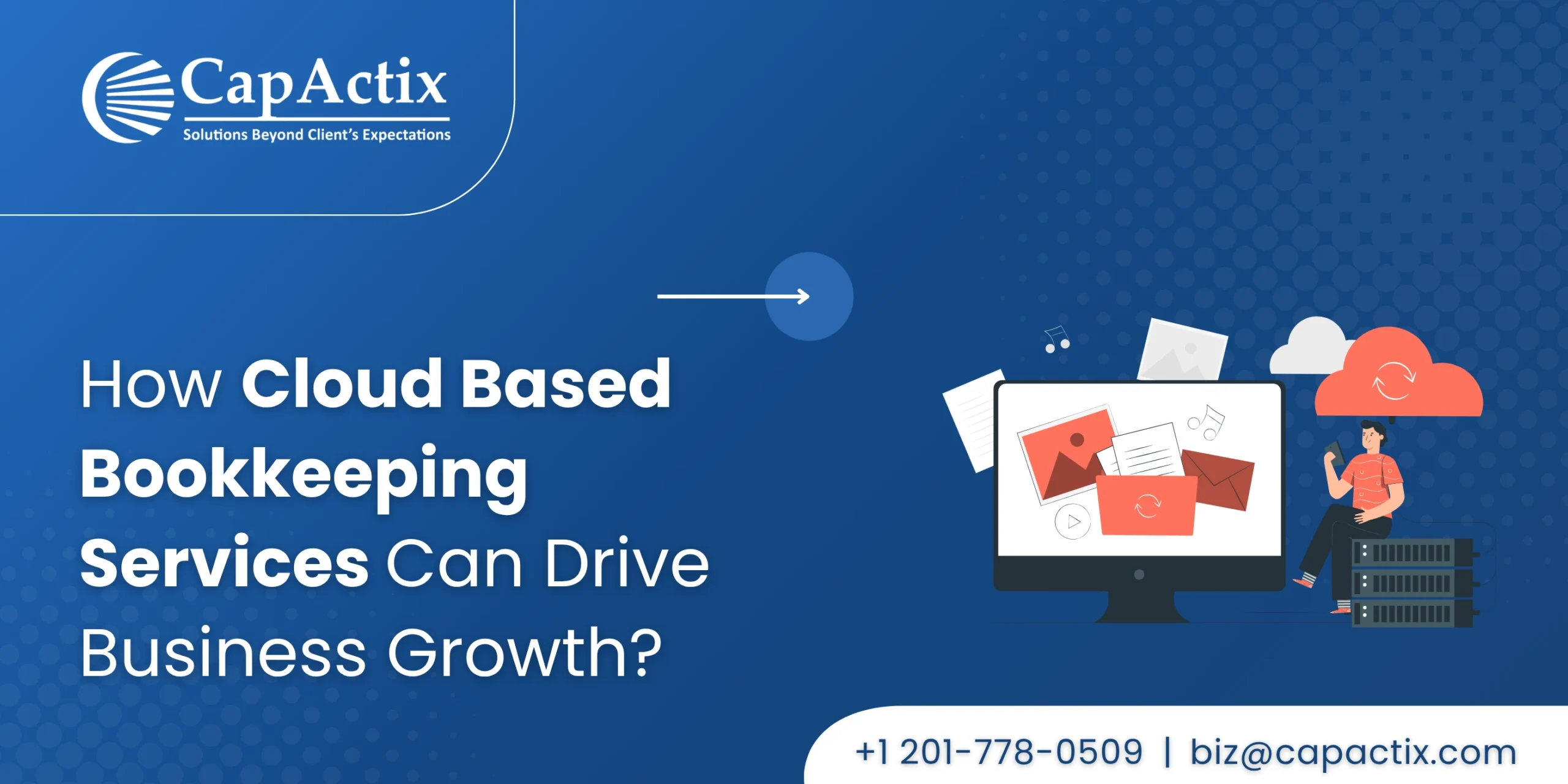One of the most important decisions a corporation must make concerns tax forms; the choice of which tax form for any kind of company is paramount. How much taxes are paid on income, how the company earns and distributes its income, and what year-round compliance requirements need to be met all depend on this. Two common corporate tax forms submitted to the IRS are Forms 1120-S and 1120.
While they are similar in function, as reporting earnings, deductions, and credits for a company, there are differences as to whether the business itself pays taxes and how shareholders report earnings. The choice between Forms 1120-S and 1120 has an immediate impact on your tax liability, growth possibilities, and long-term financial approach. Getting familiar with the differences will enable you to make the right choice for your company in terms of its size, structure, and goals.
Also Read: Step-by-Step Process for How to File a Business Tax Return Online
Understanding Form 1120-S
S-Corporations (S-Corps) file Form 1120-S as their tax return, a unique business entity that passes income, deductions, and credits to the shareholders.
Who Can File
An S-corporation filing of Form 1120-S can only be performed when the corporation has formally elected S Corporation status by filing Form 2553 with the IRS. The entity should have 100 or fewer shareholders, with all of them being either U. S. citizens or residents.
Pass-Through Taxation
One of the most significant advantages of filing Form 1120-S is pass-through taxation. The business itself doesn’t pay federal income tax at the corporate level. Instead, income and losses are “passed through” to shareholders, who report them on their personal tax returns.
No Double Taxation
Because income is only taxed once, at the individual level, S-Corps avoid the “double taxation” that affects traditional corporations.
Client Profit/Loss Reporting
Every shareholder is given a Schedule K-1 showing that shareholder’s share of the company’s profits and losses for the year. Those figures are then taken into consideration and reported on the individual return of the shareholder.
Understanding Form 1120
Form 1120 is the tax return filed by the C Corporations (C-Corps)—entities existing apart from their owners for tax purposes.
Who can file the return
Any business organized as a C Corporation must file Form 1120 annually with the IRS. There are no restrictions as to who the owners or shareholders might be. Hence, this form may be filed by smaller corporations as well as the biggest companies.
Taxes Charged to the Entity
Unlike S-Corps, C-Corps pay federal taxes on profits at the corporate level.
Corporate Tax Rate
The Tax Cuts and Jobs Act (TCJA) currently taxes C-Corps at a flat rate of 21%.
Double Taxation
When profits are paid as dividends, they are taxed in the hands of the shareholders. This leads to the basic difference between Form 1120-S and Form 1120.
Key Differences: Form 1120-S vs. Form 1120
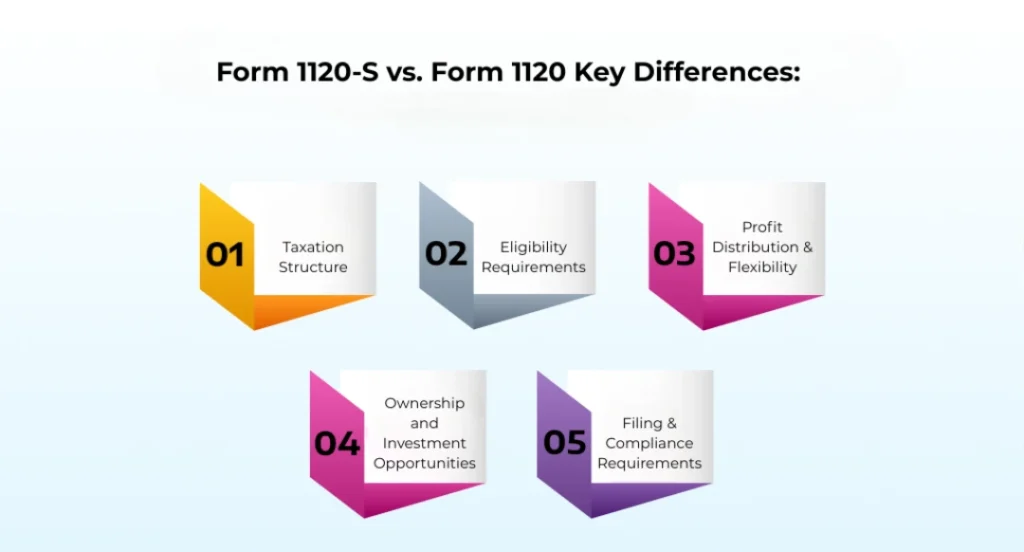
1. Taxation Structure
- S-Corp: Income passed through to shareholders, where it is taxed on their personal returns. The corporation itself pays no federal income tax.
- C-Corp: Income is taxed at the corporate level, and then dividends paid out to shareholders are taxed once more at the shareholder’s own withholding.
2. Eligibility Requirements
- S-Corp: Must not exceed 100 shareholders, all U. S. citizens or residents of the United States, and only one class of stock is allowed.
- C-Corp: No restrictions on ownership. The number of shareholders can be infinite, can be foreign investors, and can also have multiple stock classes.
3. Profit Distribution & Flexibility
- S-Corp: The laws generally require that distributions be made strictly in accordance with ownership percentage. This limits the flexibility of profit sharing.
- C-Corp: It can pay dividends disproportionate to shares held, with an emphasis on retaining earnings for reinvestment; consequently, it has higher flexibility regarding disposition of cash and means to wall off cash from shareholders.
4. Ownership and Investment Opportunities
- S-Corp: If a company is small and private, it might be viable to set up the corporation as an S-Corp, but it has restrictions on getting outside investment. Venture capitalists and foreign investors normally cannot invest.
- C-Corp: The entity is better for those companies wanting to grow rapidly or access external funding, as it allows for many types of investment structures and international shareholders.
5. Filing & Compliance Requirements
- S-Corp: Files Form 1120-S and furnishes Schedule K-1 to each shareholder.
- C-Corp: Form 1120 is filed, with possible additional schedules for credits, deductions, and dividends.
Each is liable for state corporate taxes, which can differ from jurisdiction to jurisdiction.
Advantages of Filing Form 1120-S
- Pass-Through Taxation: Profits avoid the double taxation phenomenon as they are taxed once at the shareholder level.
- Self-Employment Tax: Shareholder employees are able to pay themselves a “reasonable salary,” then take the rest of the profits as distributions, which are exempt from self-employment taxes.
- Small Businesses: It is essentially advantageous for companies that want to keep tax reporting free and clear.
- Loss Deduction Flexibility: Company losses can be deducted against other forms of income they receive, thus reducing total tax exposure.
Advantages of Filing Form 1120
- For Bigger Corporations: C-Corps can sustain unlimited shareholders and may continue scaling without any structural limitation.
- Reinvestment Potential: The company may keep the profits to use them for growth, expansion, or research and development without taxing shareholders immediately.
- Access to More Deductions: C-Corps have the benefit of more comprehensive deductions, including fringe benefits like health insurance plans or retirement bonus schemes.
- Attractive to Investors: This kind of structure is more attractive to venture capitalists, institutional investors, and foreign investors.
How to Decide Between Form 1120-S vs. Form 1120
It is not a decision that can be made without considering the specific circumstances of your business structure and goals, as well as how you expect profits and investors to flow through the business. Each option offers distinct advantages and tax implications in the long run, earning ramifications, and development strategy.
Business size and structure
Generally, the S-Corp entity is supposed to benefit smaller, owner-managed ventures or family-type businesses. Since income passes through, companies do not pay tax at the corporate level; profits or losses appear on the personal tax returns of the owners, thereby avoiding double taxation and simplifying taxes for households. Look at how the S-Corp election can come into its own and save taxes for a consulting company with three shareholders. Larger enterprises, especially those that want to go public or hope to expand, are mostly into C-Corp status, considering the scalability and flexibility of filing Form 1120.
Growth and funding goals
If the goal is capital raising, venture capitalist attraction, or international expansion, a C-Corp structure would be more suitable. Venture investors and foreign shareholders are restricted from investing in S-Corps, thereby limiting the growth potential. C-Corps can create multiple classes of stock for ease of fundraising and investor compensation. For instance, a technology startup planning to recruit global investors would have an application that would benefit from filing as a C-Corp in Form 1120.
Shareholder needs and expectations
S-Corp is particularly suited for closely held companies that desire straightforward tax treatment and do not envision many investors. Profits and losses are shared among all shareholders in proportion to their ownership and hence are equitable, but this reduces flexibility. C-Corps, conversely, allow differential dividend distributions and are better suited to investor profiles who want growth through retained earnings rather than direct payouts.
Tax planning and flexibility:
The decision will also rely on your income patterns and long-term strategy. C-Corps pay a flat 21% federal tax, whereas bigger businesses ought to retain earnings for investment, an advantage, whereas S-Corps have income distribution flexibility, reducing exposure to taxes by smaller firms. It is advisable to seek a CPA or tax professional’s assistance to analyze all aspects of your federal and state tax impact, especially if your revenues are inclined to seasonal fluctuations or you operate in several time zones.
Common Mistakes to Avoid
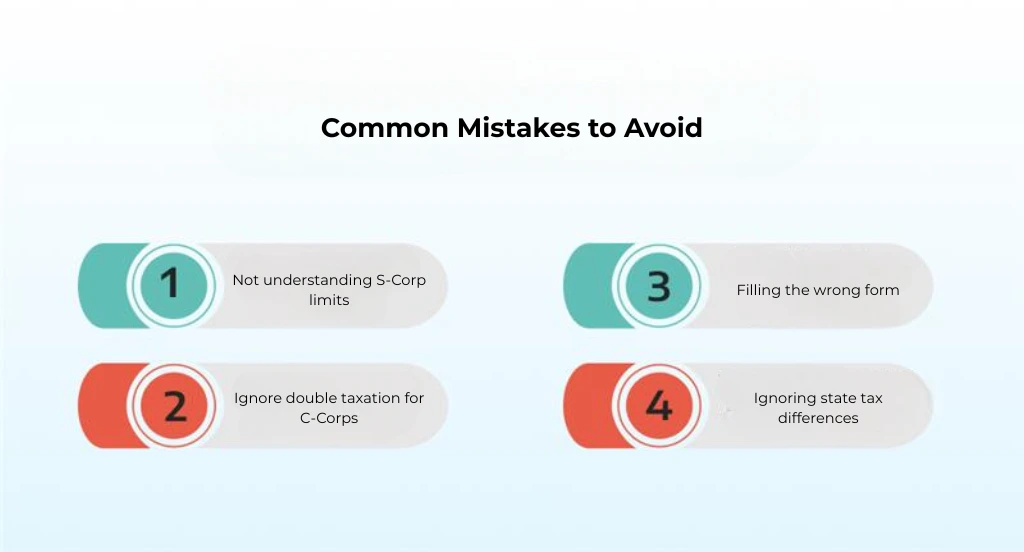
Not understanding S-Corp limits
Many new business owners opt for S-Corp status without ever realizing the strict restrictions. IRS allows an S-Corp a maximum of 100 shareholders, all of whom must be U. S. citizens or residents; moreover, the S-Corp may not issue more than one class of stock. Not adhering to the restrictions cancels the S-Corp status, landing the shareholder-assignees with back taxes or penalties. Always check eligibility before submitting Form 2553.
Ignore double taxation for C-Corps
Business owners often understate the weight of corporate taxes being assessed with dividend taxes. From the 21% tax on the figures earned at the corporate level, C-Corps pay dividends on which shareholders are paid taxes again. This could go in fine for companies where the cash flow is plowed back into the company. However, when the owners start living off the company through regular distributions, they may find this asinine situation resulting in higher overall taxes. Proper planning with respect to profit retention or compensation can ease the impact.
Filling the wrong form
Mixing up the Form 1120 with 1120-S occurs more frequently than one would think, especially after corporations undergo conversions or ownership changes. Filing the wrong form might mean immediate rejection from the IRS or later penalties for an incorrect submission. Always double-check if your business is a C-Corporation or S-Corporation and hence make sure that the accountant or the tax software reflects those accurately prior to filing.
Ignoring state tax differences
At times, the federal tax structure is not congruent with state laws. Some states do not acknowledge the S-Corp election; thus, they continue to tax the entity as a C-Corp, while others impose franchise or excise taxes on it. Knowing the different rules governing states beforehand may save you from surprise liabilities and ensure that you are fully compliant at the federal and state levels.
FAQs
It is used by S Corporations with pass-through taxation, and Form 1120 is for C Corporations taxed at the corporate level.
Yes, a company can become an S-Corp by filing Form 2553 with the IRS. The company must meet all requirements for S-Corp status, including shareholders and stock restrictions.
Not always. While S-Corps provide tax benefits, C-Corps suit better for companies wanting to grow, attract investors, or reinvest profits.
Conclusion
Filing one’s taxes on Form 1120-S vs Form 1120 is more than just an exercise in paperwork. It is about how your business is taxed, grows, and attracts investment. S-Corps appeal for their simplicity, pass-through taxation, and savings benefits to smaller or family-owned companies. C-Corps, conversely, appeal for their flexibility, ability to keep money afloat, and structure for fostering large-scale growth with some external documentation.
There is no one-size-fits-all answer. The correct choice depends on how you are structured with owners, how expansion is to happen in the future, and on the overall tax considerations. Always consider help from a professional company or tax filing expert to choose the right form.





